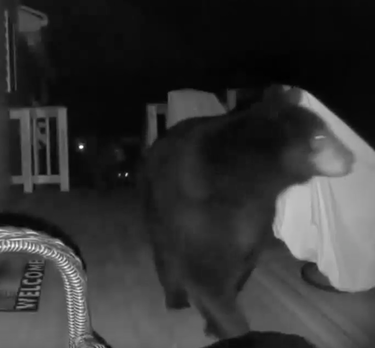Three bears, rather than a bunny, make a quiet Easter visit
KNOX — Goldilocks wasn’t home — but the Muias were, snug in their beds — when three bears took a stroll across the upstairs porch of their home on the Berne-Altamont Road.
The family had been out for a nice dinner on Easter Sunday, Frank Muia told The Enterprise on Monday, and all six of them went to bed before 8:30 p.m.
Early Monday morning, Muia saw there was something recorded on his security camera at 9:03 p.m.
He told his wife, “We’ve got something on the camera.” She said, “Oh, my God, do we have something spiritual?”
“No it’s a bear,” he replied.
The 10-second clip shows a huge bear, having climbed up the porch steps, lumbering across the porch with two adolescent cubs sauntering behind her. Out of the camera’s view, Muia says, the bears must have walked down the porch steps on the other side.
“We’ve been living here for 17 years,” Muia said. “We have cameras everywhere and never seen a bear — ever.”
He named some of the animals they have seen over the years — deer, mountain lions, lynx, fox, porcupines, and “a huge snapping-turtle parade going across the back field.”
“We’ve just seen so many animals, but never a bear,” Muia said, giddy with excitement.
The reason they’ve seen so many animals, he said, is because their property backs up to the undeveloped Helderberg escarpment.
“Before they put the solar field in behind us, the animals used to come off the mountain and they used to walk through the property in all different areas,” he said.
But now, with the solar facility surrounded by a “big fence with three strands of barbed wire,” which stretches a quarter of a mile, the wild animals “have to either walk out to Old Stage Road and come down or they can walk to where the fence ends, right on the corner of my property in the back,” he said.
Consequently, the Muias have been seeing more wildlife coming through their backyard as it’s “the only way around that fence now,” he said.
Since seeing the video, Muia has been researching bears and learned that cubs are born in January and stay with their mothers for 14 to 17 months. “So these must be last January’s babies,” he said. “They’re not babies anymore.”
The National Park Service says black bear cubs will remain with their mother for about 18 months or until she is ready to mate again; by their first birthday, in January, the cubs can weigh 80 pounds.
Muia estimated the cubs that walked on his porch each weighed 60 to 70 pounds. By measuring the porch furniture that the bears walked by, Muia tried to gauge the size of the big bear in front. “I came up with three- to four-hundred pounds, easy,” he said.
“It was a cool mama bear,” he said, marveling at the size of her belly.
Every spring, the state’s Department of Environmental Conservation puts out a press release, advising residents to secure garbage and remove bird feeders so as not to attract bears to their property.
None of that applies to the Muias, Frank Muia said. They have no bird feeders out. And their garbage and grill are in their enclosed garage.
“There’s nothing here. They’re just on a stroll ..,” he said, concluding of the bears’ visit. “That was our Easter present last night.”
DEC advice
“In New York State, people and black bears often find themselves living nearby one another,” says the DEC on its website. “Bears can obtain all of the nourishment they need from the forest, but they are intelligent and opportunistic animals. They will find and consume the easiest food they can access.”
A common conservation slogan is: A fed bear is a dead bear. This is because bears that become used to eating food from humans often become problematic and have to be killed.
The DEC provides a list of tips for back-country visitors, for campers, and for homeowners.
The home tips include:
— Remove bird feeders by April 1. New York’s black bears begin emerging from their winter dens in mid to late March. Bird feed such as suet and seeds are a very strong attraction for bears, even if they can't reach them;
— Garbage is extremely attractive to bears and should always be kept in sealed garbage cans inside a sturdy building like a garage or shed. Anything with an odor can attract a bear.Bear-resistant trash containers can be purchases and garbage odors can be masked with ammonia-soaked rags;
— Remove the grease can from grills after every use. Turn the grill on “high” for several minutes after you are done cooking to burn residual odors off the grill;
— Do not place food outside to attract wildlife. Any food items used to attract birds, squirrels, or other wildlife will also attract bears;
— Do not feed pets outside. Leftover food or even an empty dish can attract a bear;
— Do not operate refrigerators or freezers outside or on porches. Bears can smell what is inside; and
Electric Fencing is an effective tool for keeping bears out of apiaries, chicken coops, compost, and gardens.
Intentionally feeding bears is illegal. The regional DEC office should be called at 518-357-2355 Schenectady to report damage caused by black bears.
The DEC’s Black Bear Response Manual outlines the response to various situations in which bears interact with people.


